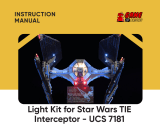
.
20. Remove the completed ailerons from your work surface. Both ailerons should now be sanded smooth. Use a long T-bar
sanding tool and 80 grit sandpaper to smooth both sides and the leading and trailing edges of each aileron (80 grit cuts
quickly, so don t over do it). Now carefully inspect each aileron for nicks, dings, etc. Use a light filler, such as "Model
Magic", to patch any problem areas. Once the filler has set, again use the long T-bar sander, with 220 grit sandpaper, to
sand each aileron completely smooth.
21.
As shown on the plans, the leading edges of the ailerons are
chamfered 45 deg. to allow the extreme aileron and flaperon travel
typically used on this design. The quickest and easiest way to do this
is to use a pencil to draw a center line on the face of the leading
edge of the aileron. Next, mark a point at one end of the aileron, 1/8"
behind the leading edge. Make another mark at the other end of the
aileron, again at 1/8" behind the leading edge. Use a straightedge
and pencil to connect the two marks, giving you a pencil line 1/8" behind the leading edge and parallel with it. Do the same
thing to the other side of the aileron. Use a long T-bar sanding tool and 80 grit sandpaper to uniformly sand the corners off
the ailerons leading edge at a 45 deg. angle. As you sand, adjust the angle of the T-bar to eventually meet the centerline
and the line behind the leading edge. When satisfied, turn the aileron over and repeat the process. When complete you
should have a uniformly angled leading edge on each aileron.
22.
As shown on the plans, each aileron is hinged to its wing panel with four (4) Easy
Hinges. Using the plans, mark the location of each hinge onto both the ailerons
and the wing panels. With a hobby knife and a #11 blade, cut each required
hinge slot into the ailerons and wing panels. The slots need to be at least 1/2"
deep and wide enough to accept the Easy Hinges. Trial fit a hinge into each slot
to assure a good fit. Trial fit each aileron in place to its appropriate wing panel.
When satisfied, remove the ailerons and set the hinges aside for later use after
the wing panels are covered.
23.
From the parts bag in your kit, locate the 1"x8" length of fiberglass tape. As
shown on the plans, cut four (4) pieces of fiberglass tape measuring 1/2"x3/4".
These will be placed over the laser cut aileron control horn holes, top and bottom,
to reinforce these areas. Lay the cut piece of fiberglass in place over the holes
and flood the tape with thin CA glue until the weave is full. Allow to set and repeat
the process with the other side of the aileron. Repeat the process on the
remaining aileron. Use sandpaper to lightly sand the glass smooth.
BUILDERS TIP: After cutting the
fiberglass to the right dimensions, hold
the piece with a pair of tweezers or
hemostats and lightly spray one side
with 3M 77" spray cement. The glass
will then stay in position on the wood,
ready for CA.
Stabilizer, Fin, Elevators And Rudder
24.
Beginning with the stabilizer, locate part numbers S-1, S-2, and S-3 (2 each). Pin or weight S-1 securely in place over the
plan, carefully lining up its rear edge with the drawing. Apply glue to the rear edge of S-2 and position it in place to S-1 -
weight or pin in place and wipe off any excess glue. Glue an S
-3 tip to each side of the stab assembly and pin or weight in
25.
With the stabilizer still in place on your work surface, the elevator halves can now
be built. Locate laser cut part numbers E-1, E-2, and E-3 (2 each) and also E-4
and E-5. Protect the stab from glue with a strip of wax paper along its rear edge.
Position part E-
2 in place against the back edge of the stab, directly over the plan
- pin or weight in place. Apply glue to the front edge of E-1 and glue it in place to
the back edge of E-2 - weight or pin in place and wipe off any excess glue. Glue
elevator tips E-3 in place to the ends of the E-1/E-2 assembly. As shown on the
plans, glue E-4 in place to the left elevator half at the inboard edge of the E-1/E-
assembly. Glue E-5 (with the laser cut elevator horn holes) to the right elevator
half, on the inboard side of the right E-1/E-2 assembly.
26.
Remove the elevator halves from your work surface. From the parts bag provided in your kit, locate the pre-bent 1/8" dia.
wire elevator joiner. As shown on the plans, this joiner fits into each elevator half. Use a pencil to mark the location of the
required 1/8" dia. holes that must be drilled into the leading edge of each elevator half to accept the wire joiner. To best
control the centering of these holes, we suggest using a non-
powered twist drill. Make each hole 1" deep and at 90 deg. to
the leading edge of the elevator halves. The leading edges of the elevator halves, from the just drilled holes, inboard
5 parts, must now be grooved to accept the 1/8" dia. wire joiner.






















